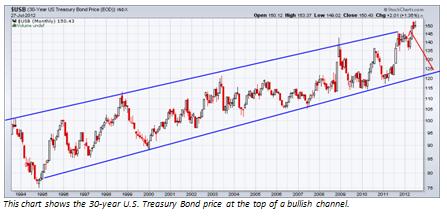Did we just see a top for bonds?
I shudder to think what that may mean.
Bond prices went higher for many reasons: the manipulation by the Fed, retirees seeking risk-free income and a mass exodus from European holdings into “safer” U.S. debt.
But bond yields have recently rebounded. When yields on bonds increase, people are selling
Europe has become a financially safer place over the past few days. Perhaps selling in the U.S. bond market is a result of the European bond investors taking money back from short-term U.S. debt investments.
Another option is that retirees decided that yields were too low, forcing different income strategies. Other institutional clients may have thought the same thing and sold U.S. debt holdings.
No matter what the reason for the selling, U.S. bond prices appear ready to sink further.
This chart shows the 30-year U.S. Treasury Bond price at the top of a bullish channel.
Incredibly, I have been following this chart for years with minimal changes. In fact, the last projection I made using this chart was in December when I expected one more high followed by a massive pullback.
Since December, U.S. Treasuries crept higher, which surprised many investors given the weakness in the economy and the prevailing record-low bond yields.
Had those investors simply been aware of the multi-decade bullish channel, bond bears would have shied away from levered vehicles like the ProShares Ultra Short 20+ Year Treasury (NYSE: TBT) and saved money for a better entry … like right now.
Following the upper blue line in the chart, notice the large pullbacks that ensue after each kiss. The kisses are rare, occurring only five times (1993, 1998, 2003, 2008 and since 2011).
Normally, bond prices will reverse quickly after the upper channel is hit. This time has been different, probably because of the Fed’s intervention in the bond market.
But not even the Fed can defy gravity. Bond prices cannot stay high for long and they will eventually need to fall all the way back to support.
This decline will likely happen rather quickly. Based on the expected rapid decline, bond prices should hit the 125 level within 10 months.
That’s a 17% decline, which would raise rates to around 3.15% (bond prices and bond rates are inversely connected).
The decline in July has all the makings of a major top in U.S. bonds (I’ll save that analysis for a later date). However, investors must begin to recognize that a major top is very near.
If indeed bonds topped, there would be an incredible amount of free money entering the system. Capital previously stashed in long-term debt would soon be available, leading to other opportunities.
As mentioned before, TBT is an excellent way to profit from a decrease to bond prices. However, a decrease in bonds may have other ramifications, which may offer even better investment returns.
As investors sell bonds, cash previously locked up in a long-term investment is freed. Perhaps this newly freed cash will go nowhere, perhaps sit in the bank.
But consider if it flows elsewhere.
Billions would move into stocks, sending the market significantly higher despite the global economy and high unemployment. An increase in yield may also spark inflationary fears, sending massive amounts of money into commodities and real estate.
So over the next few months, prepare yourself and your portfolio for a major shift in bond yields.
 Facebook
Facebook
 Twitter
Twitter
